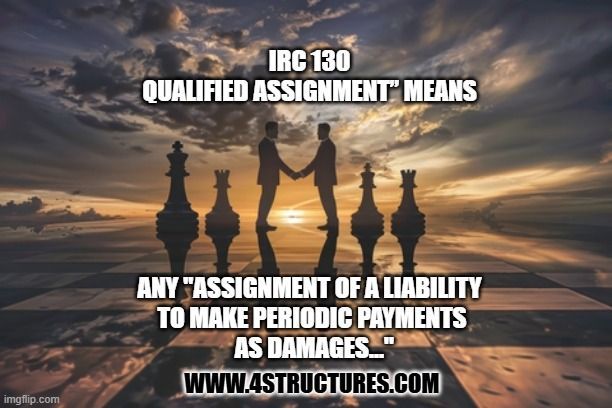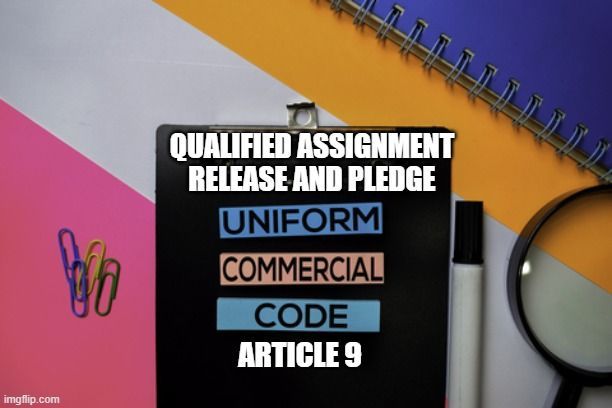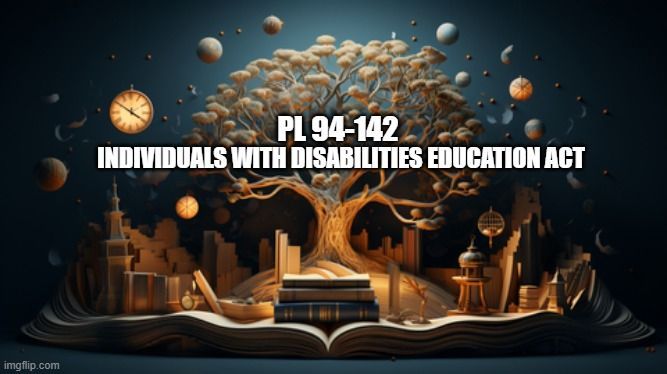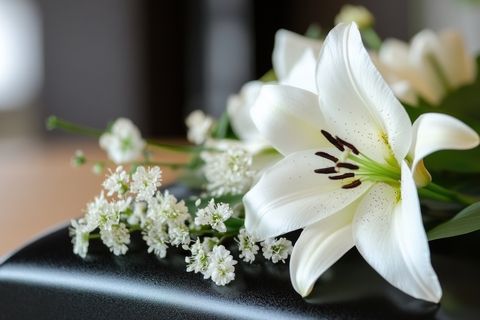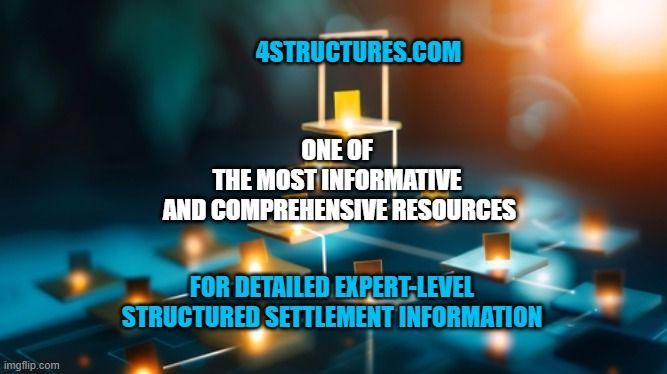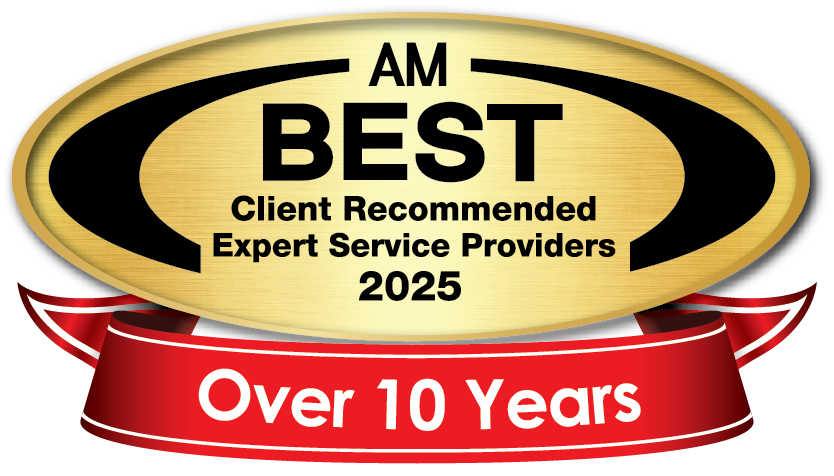History of Structured Settlements | What You Need To Know
Structured Settlement History| Simmering for More Than a Century

1918 Revenue Act of 1918, ch. 18, § 213(b)(6), 40 Stat. 1057, 1066 (1919) exempted damages for “personal injuries or sickness” f rom taxation, apparently because Congress believed it “doubtful” whether such damages constituted “income” within the meaning of the Sixteenth Amendment and thus, whether they could constitutionally be taxed Initially
1922 Damages for various non-physical injuries (i.e., alienation of affection, defamation, etc.) were likewise deemed tax exempt
1928 Wrongful Death Tax Ruling The IRS rules that an award paid by the Mixed Claims Commission of the U.S. and Germany to the surviving spouse of a passenger on the Lusitania is not taxable since the award is designed to "restore [the decedent's wife] to substantially the same financial and economic status as she possessed prior to the death of her husband.
1930s Great Depression Investors began turning to annuities as a safe haven from volatile markets.
1954 IRS Code Section 104 establishes that cash settlements of personal injury cases are tax exempt.
1960 Revenue Ruling 60-31 Situations 1-3, 1960-1 C.B. 174, holds that a mere promise to pay, not represented by notes or secured in any way, does not constitute receipt of income within the meaning of the cash receipts and disbursements method of accounting.
1960s Severe birth defects arising from the use of the drug Thalidomide resulted in more claims against than the manufacturers could pay. Periodic payments from a trust were used to compensate Thalidomide victims to a greater degree than would have been possible at the time in a lump sum cash settlement.
1965 Knuckles v. Commissioner of Internal Revenue Service 349 F.2d 610The determination of whether a settlement amount is excludable must be based on the reason for settlement, which is determined by the wording of the original complaint.
1975 The Medical Injury Compensation Reform Act (MICRA) is approved by the California Legislature in September 1975. Under MICRA, non-economic damages are limited to $250,000. Non-economic damages include claims for pain and suffering, loss of consortium, both of which permit the financial recovery for losing limbs, losing sight or hearing, the ability to walk, and all other losses that do not directly relate to economic losses. Attorney fees are paid on a decreasing sliding scale. There is a shortened statute of limitations and doctors are permitted to pay the award over time [see California Codes: Business & Professions Code Section 6146, Civil Code Sections 3333.1 and 3333.2, and Code of Civil Procedure Section 667.7. ]
1978 General Counsel Memorandum 37687, September 25,1978
Periodic payments are fully excludable when the Casualty company agreed to make fixed periodic payments to Claimant for the longer of twenty years or Claimant’s life, provided that Claimant does not have actual or constructive receipt of the economic benefit of the present value of the damages.
1978 Private Letter Ruling 7905017. October 31,1978 Periodic payments are fully excludable when:
•Casualty company agreed to make fixed periodic payments to Claimant for the longer of twenty years or Claimant’s life
• Casualty company purchased an annuity from its affiliate to provide a source of funds to satisfy the obligation
• Casualty company is the owner of the annuity and has all rights of ownership,
including the right to change the Beneficiary
• Casualty company instructed the affiliate to make payments directly to the Claimant
• Claimant has no right to the discounted present value of the periodic payments or to control the investment of that amount
• Any payments to Claimant’s estate are similarly excludable from
income.
1979 Private Letter Ruling 7933078, May, 21,1979 Periodic payments are fully excludable when:
• Casualty company agreed to make periodic payments to Claimant for a term certain
• Casualty company is not required to set aside specific assets to secure any part of its obligation
• Claimant does not have the right to accelerate any payment or to increase or decrease the amount of any payment
• Claimant’s rights against casualty company are no greater than those of its general
• Payments are not subject to assignment, transfer, commutation or encumbrance
• Casualty company is obligated to make final payment of a specific amount to Claimant’s estate in lieu of the obligation to make further payments if the Claimant should die before a specific date
• Casualty company also agreed to reimburse Claimant for future medical expenses that do not exceed a sum certain, and any such reimbursement must be offset against actual future medical expenses
1979 Revenue Ruling 79-220 . IRS issues guideline Revenue Ruling which serves to assure that periodic payments will flow tax-exempt on personal injury, structured settlement cases. Of note, the ruling spells out that “the recipient may exclude the full amount of the payments from gross income under IRC §104(s)(2) of the (IRS) Code not just the discounted present value. Payments made to the estate after the recipient’s death are also fully excludable.”
1980 Private Letter Ruling 8020095, February 25,1980 Periodic payments are fully excludable where:
• Defendant agreed to make fixed periodic payments to Claimant
• Defendant reserved the right to purchase an annuity to provide a source of funds to satisfy the obligation and reserved the right to assign its rights and duties
• Defendants terminated its obligations to claimant by assigning its rights and duties to Assignee and paying Assignee the sum of Y
• Assignee was required to use the entire sum of Y to purchase an annuity sufficient to make the periodic payments to Claimant and was required to instruct the issuer of the annuity to make payments directly to Claimant
• Neither Claimant nor Claimant’s estate has the right to accelerate, increase or decrease the amount of any payment
1980 Medicare Secondary Payor Act (MSP) . Prior to the MSP, Medicare paid medical benefits for its beneficiaries without specific regard to whether the beneficiary had other sources of payment for medical needs. The MSP Act in 1980 was intended to decrease Medicare costs by requiring certain insurers,
including liability, automobile, no-fault and workers compensation insurers, to make payment first for services to Medicare beneficiaries regarding claimed injuries, with Medicare responsible only as a “secondary payer.”
1982 Private Letter Ruling 8307015, November 10, 1982 Periodic payments are fully excludable when:
• Defendant agreed to make fixed periodic payments to
• Defendant was given the right to assign and arrange for the assumption of its obligations
• Pursuant to an assumption agreement entered into by the parties, defendant terminated its obligations to Assignee
• The assumption agreement gave Assignee the right but not the duty to purchase an annuity to fund the
• Assignee instructed the issuer of the annuity to make payments directly to Claimants, and these instructions cannot be revoked or modified without Claimants’ written consent
• Neither Defendant nor Claimants have any ownership or other rights in the annuity
• Claimants will have recourse only against Assignee in the event of a default under the settlement or assumption agreements
• Claimants will not actually receive funds until the annuity payments are made and have no present right to receive payments.
1982 California Supreme Court rules that the California Medical Compensation Reform Act (MICRA) is constitutional
1983 Periodic Payment Settlement Act of 1982 (Also known as P.L. 97-473). Codified various tax rulings into law and created IRS Section 130 which allowed for the qualified assignment of obligations to a third party (substitution of obligors).
1983 Private Letter Ruling 8333035 . IRS response to a private party that there was no tax on annuity benefits where the cost had been disclosed.
1985 Private Letter Ruling PLR 8527050, April 9,1985
- Damages in this action made due to wrongful discharge, age discrimination and State Handicappers’ Civil Rights Act violations were paid on account of personal injuries, and are excludable from gross income. Nor do they constitute wages for purposes of FICA, FUTA, or income tax withholding.
- The portion that was paid on account attorneys’ fees, costs and interest thereon is included in gross income but does not constitute wages for purposes of FICA, FUTA, or income tax withholding.
- The portion to be paid in annual installments on account of lost wages and interest thereon will be includable in gross income in the taxable year received
- Only the lost wages and not the interest thereon will constitute wages for purposes of FICA, FUTA, of withholding
1985 New York Periodic Payments of Judgments Act Article 50-A (CPLR 5031-5039) of the Civil Practice Law & Rules goes into effect July 1, 1985, requiring subject to series of calculations, that future damages in medical, dental and podiatric malpractice verdicts that were in excess of $250,000 were to be paid as a structured judgment.
1985 National Structured Settlements Trade Association (NSSTA) is founded represents licensed consultants, attorneys, insurance companies, and other professionals who work with accident survivors and their dependents.
1986 National Childhood Vaccine Injury Act includes a periodic payment provision as part of a no-fault alternative to the traditional tort system to provide compensation to people found to be injured by certain vaccines.
1986 Tax Reform Act of 1986 separated personal and physical injuries, allowing only physical injuries to be assigned under IRC Section 130. In addition, the act amended IRC Section 72(u), which further refined conditions under which owners of annuity policies used to fund non-qualified and workers’ compensation settlements would be taxed for the interest earned in any taxable year. This applies to owners who are not natural persons, such as companies .
1986 Burford v. United States 642 F. Supp. 635 (N.D. Ala 1986) All damages from wrongful death action, including punitive damages are excludable under 104(a)(2)
1986 New York Periodic Payments of Judgments Act Article 50-B (CPLR 5041-5049) of the Civil Practice Law & Rules goes into effect August 1, 1986, requiring subject to series of calculations, other types of future damages in personal injury, injury to property and wrongful death actions in excess of $250,000 to be paid as a structured judgment.
1986 Tax Reform Act of 1986 . Allows only physical injuries to be assigned under Section 130. In addition, the act amended Section 72(u), further defining the conditions under which non-natural person annuity owners of non-qualified and workers’ compensation annuity policies would be taxed for the interest earned in any taxable year
1988 The Technical and Miscellaneous Revenue Act of 1988 (TAMRA) removed language from Section 130 of the IRS Code that read “the assignee does not provide to the recipient of such payments rights against the assignee which are greater than those of a general creditor.”
1990 Private Letter Ruling 90-17011 "knowledge of the existance, cost and present value of the annuty contract used to fund the settlement offer... will not cause the family to be in constructive receipt of the present value of the amount invested in the annuity " Knowledge of Existence, Cost or Present Value is OK"
1991 Private Letter Ruling 9125017 IRS issues PLR to a private party concerning the taxability of annuity benefits where secured creditor status and a guarantee had been included.
1991 In re Monarch Capital (see In re MONARCH CAPITAL CORPORATION Debtor No. 91-41379-JFQ (D. Massachusetts August 12, 1991), 175 structured settlement annuitants were protected despite the bankruptcy filing of the assignment company, Monarch Capital, a non-nsurance entity.
1992 Private Letter Ruling 9253045 IRS issued PLR on an individual case where the plaintiff perfected a security interest in the annuity contract by filing notice in his state and in the assignment company’s state and had possession of the annuity issued by Integrity Life. The IRS ruled that this would not cause him to be taxed on the present value of the annuity contract in the year in which he received it
1992 26 U.S. Code § 468B details the tax treatment of money going in and out of Designated Settlement Funds and Qualified Settlement Funds
1993 Revenue Procedure 93-34 allows physically injured individuals receiving settlements from mass tort claims paid into a IRC § 468B(d)(2) designated settlement fund or a §1.468B-1 qualified settlement fund, to enter into structured settlements, by allowing for the settlement fund to be treated as a "party to a suit or agreement" assign its periodic payment obligation to a third party
1993 The Omnibus Reconciliation Act of 1993 (OBRA '93) created a "safe harbor“consisting of three alternative types of ”special needs trusts" (self-settled; pooled; third party) to allow disabled individuals to receive assets without disqualifying them from Medicaid
1994 Childs v. Commissioner, 103 T.C. 634 (1994) seminal decision regarding structured attorney fees. The 11th U.S. Circuit Court of Appeals ruled 89 F.3d 856 (11th Cir. 1996) that the settlement documents controlled the timing of the income and that the doctrine of constructive receipt was inapplicable
1995 Commissioner v. Schleier , the U.S. Supreme Court holds that the amount received in settlement of a claim for backpay and liquidated damages under the Age Discrimination in Employment Act fails to qualify for §104(a)(2) exclusion. In establishing a standard for excludability, Justice John Paul Stevens, wrote for the opinion for the Court, stating in part that the taxpayer must demonstrate that the underlying cause of action giving rise to the recovery is " 'based upon tort or tort type rights'; and second, the taxpayer must show that the damages were received ‘on account of personal injuries or sickness.'
1996 Small Business Job Protection Act of 1996 removed the exclusion of damages from gross income on damages received on punitive and non-physical injury awards, the latter having stood for 74 years!
1996 Weil Settlement results in greater willingness on the part of life insurers issuing structured settlement annuities to appoint plaintiff-oriented consultants and to permit the sharing of commissions between defense and plaintiff consultants on the placement of the annuities. See Weil Ins. Agency v. MANUFACTURERS LIFE INS., 815 F. Supp. 1320 (N.D. Cal. 1993)
1997 Balanced Budget Act of 1997 amended IRC §130(c) to permit the qualified assignment of worker’s compensation cases filed after August 5, 1997.
1997 BARCO Assignments, Ltd. Liberty Life Assurance Company of Boston, formerly a subsidiary of Liberty Mutual Insurance Company, launched the BARCO Assignments program. This program utilized an offshore assignment company based in Barbados and leveraged the US-Barbados Tax Treaty to prevent double taxation while managing non-qualified assignments of periodic payment liabilities. At the time, Liberty Mutual was a prominent provider of workers' compensation insurance and held significant pre-August 5, 1997 liabilities that were otherwise non-assignable. In contrast to SAFECO's Safeco National program, which permitted limited assignment of taxable damages, the creation of BARCO was instrumental in significantly expanded opportunities for the utilization of periodic payment settlements for parties in litigation. Read more about non qualified structured settlements
1997 Favorable IRS Ruling on Death Commutations of Structured Settlements. Led to introduction of Advance Funding Exchange Notice by Allstate Life Insurance Company and Allstate Life Insurance Company of New York. The IRS concluded in PLR 9812027 (issued December 18, 1997) that both the commuted lump sum as well as any remaining non commuted structured settlement payments) would continue to received an income tax exclusion under IRC 104(a)(2). Key factors in the ruling were:
- Contemplated in the original structured settlement documents and funding annuity
- Caused by events outside the payee's control (i.e death)
- The payee has no ability to affect whether a commutation might occur; and
- The commutation is made to the payee's beneficiaries and not to the payee.
1999 Variable Structured Settlement PLR is issued to MetLife. IRS Private Letter Ruling 199943002 was published on October 29, 1999 addressing the question of whether pe riodic payments of damages that are calculated pursuant to an objective formula based on the performance of the Standard & Poor’s 500 Stock Index and/or a mutual fund portfolio designed to achieve long-term growth of capital and moderate current income are "fixed and determinable as to amount and time of payment" under § 130(c)(2)(A)
1999 Tax Treatment of Structured Settlement Factoring Proceeds to the Seller. In Private Letter Ruling 119273-97 the IRS concluded that the lump sum received from the sale of structured settlement payment rights retained the same tax treatment that it was accorded prior to the structured settlement factoring transaction
2001 Victims of Terrorism Tax Relief Act of 2001 (VTTRA) is passed. Incorporated with is the Structured Settlement Protection Act (SSPA) which establishes IRC 5891. IRC 5891 levies an excise tax of 40% on the buyer of structured settlement payment rights from sellers for non-compliant structured settlement transfers. IRC 5891 is the only place in the Internal Revenue Code where structured settlement is defined
2001 CMS Issues the Patel Memo representing the first of a series of CMS policy memoranda on workers compensation Medicare set-asides (WCMSAs), including structured settlements.
2002 New York Structured Settlement Protection Act
(NY General Obligations Law § 5–1701 et seq.) was enacted in response to factoring companies using “… aggressive advertising, plus the allure of quick and easy cash, to induce settlement recipients to cash out future payments, often at substantial discounts, depriving victims and their families of the long-term financial security their structured settlements were designed to provide” (N.Y.S. Legis. Memo. Ch. 537, 2002; McKinney’s 2002 Session Laws of N.Y., at 2036). The New York Structured Settlement Protection Act also creates a duty on the Defendant or Defendant's legal representative to make an initial disclosure of structured settlement terms (NY General Obligations Law § 5–1702) in writing.
2002 Society of Settlement Planners ("SSP") is founded
2003 Sixth Circuit Rules on Constitutionality of Tax Treatment of Damages for Physical Injury in Employment Case United States Court of Appeals, Sixth Circuit. Johnny Paul YOUNG, Plaintiff-Appellant, v. UNITED STATES of America, Defendant-Appellee. No. 01-6362. Decided: April 28, 2003. The taxation of nonphysical injury damages and the non taxation of physical injury damages is constitutional according to the Sixth Circuit Court of Appeals. The taxpayer unsuccessfully argued that the difference in tax treatment violated the equal protection statute.
2003 AEGON withdraws from the structured settlement market announcing it will no longer issue structured settlement annuities on July 9, 2003.
2008 RSP professional designation . The Registry of Settlement Planners unveils the Registered Settlement Planner professional designation in conjunction with Texas Tech
2008 Non Qualified Assignment Tax Ruling for Employment Cases IRS Private Letter Ruling PLR 200836019, addressed the use of a non qualified structured settlements in an employment context (i.e. taxable damages), ruling favorably on the non qualified structured settlement transaction
2009 John Darer of 4structures.com LLC is the first Registered Settlement Planner (RSP)
2013 Allstate and John Hancock cease writing new structured settlement annuities in Q1 2013
2013 ELNY Liquidation . Executive Life Insurance Company of New York is liquidated August 8, 2013, 22 years after it went into rehabilitation
2014 MSSC professional designation . John Darer from 4structures was part of the Inaugural NSSTA Master Structured Settlement Consultant certification course helat University of Notre Dame in September 2014. An MSSC® Certification is another layer of professional education and qualification. The MSSC® program provides a comprehensive understanding of structured settlements, combining academic rigor and perspective with the latest developments impacting the industry. Minimum seven years of structured settlement industry experience.
2014
Pacific Life Introduces Index Linked Annuity Payment Adjustment Rider (ILAPA) and receives favorable Private Letter Ruling . Pacific Life receives favorable IRS Private Letter Ruling 201435006 concerning its Index Linked Annuity Payment Adjustment rider (ILAPA). Payments are adjusted annually based on annual changes in the S&P 500 with a 5% cap and are income tax free assuming the damages paymnets represent are excluded under IRC 104(a)(2). Pacific LIfe's PLR also includes the possibility of a hardship commutation The possibility of a commutation by Claimant pursuant to the Notice of Hardship Conversion will not affect whether the structured settlement assignment satisfies the requirements of a qualified assignment under § 130(c). The annuity purchased by Assignee will not fail to be a qualified funding asset under § 130(d) by reason of the Notice of Hardship Conversion.
2015 The Congressional Structured Settlement Caucus is established to help educate Members of Congress on the important public policy values of structured settlements. The Caucus is focused on federal legislative and regulatory efforts to preserve, promote, protect and defend structured settlements. The critical agenda objectives for the Members of the Congressional Structured Settlements Caucus include:
- Educating the 128 newly elected Members of Congress on the important public policy benefits of structured settlements
- Highlighting the value and importance of Federal Tax Code Section104(a)(2) and Section 130
- Working to promote legislation to expand the use structured settlements
- Working with Congress and the Centers for Medicare and Medicaid Services (CMS) to protect the use of WC-MSAs and develop LMSAs
2015
Wrongful Incarceration Exclusion. Congress added a new exclusion from income under §139F of the Internal Revenue Code as part of the Protecting Americans from Tax Hikes Act of 2015 (PATH Act), Under this new exclusion, a wrongfully incarcerated individual does not include in income any civil damages, restitution, or other monetary award received that relates to his or her incarceration for the covered offense for which he or she was convicted
2015 John GRIFFITHS v. AVIVA LONDON ASSIGNMENT CORPORATION, Aviva Life Insurance Company, CGU International Insurance, PLC, Athene Holding, Ltd., Athene London Assignment Corporation and Athene Annuity and Life Company, Class Action lawsuit was filed June 27, 2015. The genus was six weeks of probing from August-October 2014 by lead plaintiff John Griffiths and 4structures.com LLC's John Darer that led to the discovery that the Capital Maintenance Agreement that was marketed as an intrinsic part of assignments to Aviva London Assignment Company and was said to be "absolute, unconditional and ongoing" was unilaterally terminated without notice. Plaintiffs effectively paid $500 extra out of the amount allocated to structure for the CMA. Griffiths contacted Darer in his capacity as Structured Settlement Watchdog. Aviva wrote $1B of premium from 2002-2009 while its program was active. The sale of its US operations to Athene closed in October 2013. The Griffiths v. Aviva class action lawsuit settled eventually settled in 2018. In the end the Plaintiffs received a new Capital Maintenance Agreement and a small amount of cash relief. 4structures.com LLC' John Darer did extensive write up and commentary about the lawsuit and the settlement which you can read
here
2017
Ezell v. Lexington Insurance Company et al. - In a lawsuit filed January 4, 2017, with a disgruntled former structured settlement broker turned lawyer as co-counsel, plaintiffs alleged that American International Group and multiple subsidiaries including Lexington made fraudulent representations and committed RICO violations because, among other allegations, the life insurer that sold annuities to Lexington diverted four percent to pay commissions to pay brokers who arranged the transactions with Lexington without disclosure. The representative plaintiffs were all represented in the underlying transactions by highly competent legal counsel who regularly employed structured settlement brokers and would have had knowledge of how brokers were compensated. Ultimately neither the District Court nor the Appellate courts found the plaintiffs' arguments persuasive.
The matter was initially dismissed in December 2017 without prejudice. In June 2019, the U.S. Court of Appeals for the First Circuit, affirmed the September 2018 U.S. District Court Decision to dismiss with prejudice the amended complaint in the class action lawsuit with retired United States Supreme Court Associate Justice David Souter writing the decision . 4structures.com LLC's John Darer did extensive commentary on the poorly pleaded case on the Structured Settlement Watchdog blog.
2018 Liberty Life Assurance Company of Boston ceases writing new structured settlement annuities in Q1 2018. Liberty Mutual sale to Lincoln Financial Group announced in February 2018. The structured settlement block is reinsured by Protective Life which handles the servicing. See
Liberty Life of Boston Sale to Lincoln Financial Group.
2018 Back to $6B Structured settlement industry production exceeds $6B for the first time in a decade.
2018 Factoring companies associated with Owings Mills natives Ryan Blank (also of Boca Raton FL)_ and Richart Ruddie (also of Ft. Lauderdale, FL), including Annuity Sold LLC and its affiliated companies (Uber Funding, LLC, Bendermere Capital Solutions, LLC, Axis Funding, LLC, Stonebridge Capital, LLC, Greenspring Funding, LLC, LSG, LLC, Preak Street, LLC, ILILIL2010, LLC, Palantir Packaging, LLC, JRR Funding, LLC were banned from doing business in Maryland for 7 years after an investigation by the Maryland Attorney General Brian Frosh.
2019 Record structured settlement industry production exceeds $6.4B, its best year ever, despite low interest rates.
2019 The National Association of Insurance Commissioners (NAIC) makes clear in its Statutory Issue Paper No. 160 (finalized April 6, 2019), that structured settlement receivables (acquired structured settlement payment rights on the secondary or tertiary market) are not an insurance prodict. See new footnote 1: "This guidance is specific to acquired structured settlement income streams (legal right to receive future payments from a structured settlement) and does not capture accounting and reporting guidance for the acquisition of any insurance product (e.g., life settlement, annuities, etc.)".
Despite this guidance, some merchants of such receivables (payment rights) continue to refer to them as annuities in 2024.
2019 On June 11, 2019, a First Circuit Court of Appeals panel in Ezell vs Lexington Insurance Company, unanimously found that amounts deducted from settlement payments did not constitute fraud. Writing for the Court, retired Supreme Court Justice David Souter noted that the settlement language did not promise that the claimants would receive a certain amount; rather, the agreements stated that a certain amount of money would be “annuitized” to purchase revenue streams for their benefit. In this case, there was no dispute as to whether Lexington actually spent the listed amount to purchase the payment streams. The settlement agreements also set forth the payment stream each claimant would receive, and there was no dispute that these amounts were actually paid. Furthermore, the three appellants conceded that these “missing” funds were paid to brokers at a market rate. As such, Justice Souter stated that these commission payments “would have been accounted for as a standard element of the cost of doing business by the life insurance companies and reflected in the market prices that Lexington paid.” Ezell, at *6. The terms of the settlement contract mandated the Lexington produce a stream of payments for the claimants; therefore, the claimants received “exactly those specific annuity payments the agreements had promised.” Ezell, at *7
2020 NSSTA holds first virtual annual meeting. Industry production down after two record years of production, the coronavirus impact saw industry production down
2020 Increasingly diverse product offerings as Assura Trust introduces Growth Structured Settlement strategy which pairs a fixed annuity with a trust owned Vanguard Fund for both plaintiffs and attorney fee deferrals. Structures, LLC offers Fee Structure Plus and Settlements Plus (Closed Architecture), which offers a limited selection of ETFS to fund period payment obligations in addition to a managed portfolio option.
2020 Maryland adopts and incorporates the 2017 Revisions to the Life & Health Guaranty Associations Model Act . See SENATE BILL 186 / HOUSE BILL 141 (CHAPTER 74 / CHAPTER 73) - LIFE AND HEALTH INSURANCE GUARANTY CORPORATION ACT --
- Excludes coverage for a person who acquires rights to receive payments through a structured settlement factoring transaction. The Model Act offers no respite for investors who have acquired such rights before such adoption became effective.
2021 American Association of Settlement Consultants (AASC) is formed following Sage Settlement Consulting departure from NSSTA. Although the new association has said it intends to be controlled by brokers and consultants with no insurers on its board of directors, they are welcome as sponsors. It was to have its inaugural meeting live in Las Vegas Nevada in the late Fall but was postponed to February 2022 out of an abundance of caution as the Covid-19 Delta variant was rampant.
2021 Both NSSTA and Society of Settlement Planners have successful virtual annual meetings. While both NSSTA and AASC had planned in-person educational meetings in October 2021, NSSTA decided to continue with virtual format and AASC postponed its inaugural meeting until February 2022.
2021 New Hampshire becomes the 50th state to pass a Structured Settlement Protection Act. Together with the District of Columbia, there are now 51 jurisdictions with a Structured Settlement Protection Act.
2021 Wilcac Life Insurance Company enters the primary structured settlement marketplace in October 2021. The name Wilcac is a portmanteau of Wilton Re and Continental Assurance Company, the latter acquired by Wilton Re from CNA in 2014.
2021 Independent Life Insurance Company introduces the first Duration Based Structured Settlement Compensation Model, which uses a 3 tier compensation model that pays less commission for structured settlement annuities with less than 10 years duration, with increases for durations of 10 plus years and 20 plus year durations. By doing so Independent aims to bring added value to shorter term structured settlements at a time when short term rates were depressed.
2021 Independent Life Insurance Company introduces iStructure, the first uncapped fixed index structured settlement annuity in December 2021.
2022 Metropolitan Tower Life opens up its structured installment sales product to 49 States (all states except New York) in January
2022 In February, the American Association of Settlement Consultants (AASC) holds its first live meeting in Las Vegas.
2022 In February, government bond rates return to mid-2019 levels
2023 Yield on United States government bonds continue to increase, reach 2007 levels. Structured settlement placements explode, helping to stimulate to record industry production.
2023 40 US States now expressly now expressly exclude acquired structured settlement payment rights/ structured settlement receivables (i.e. other people's structured settelments) from statutory insolvency schemes, having adopted the 2017 revisions to the Life & Health Guaranty Associations Model Act (#520). Structured settlement receivables have been marketed to investors as secondary market annuities, SMA, SMIA. The Model Act provides that the exclusion regardless of when the structured settlement payment rights (receivables)were acquired.
2023 New Rules for Minor's settlements in Tennessee. The State of Tennessee amended (Tenn. Code Ann. § 29-34-105). Court approval is waived unless the settlement is greater than $10,000; (2) the minor is unrepresented by local counsel; or (3) the minor's settlement involves a structured settlement.
2023 Prudential Insurance Company of America rolls out Prudential Structured Settlement Income Advantage, a new indexed structured settlement with a domestic qualified assignment company. The IRS issued Private Letter Rulings to both the annuity issuer, Prudential Insurance Company of America and to Prudential Assigned Settlement Services Corpration (PASSCORP), its qualified assignment company.
2023 The Structured Settlement Industry ended the year 2023 having propelled itself to the best production year in structured settlement industry history.
2024 In a major development in the fight for predatory structured settlement factoring accountability, in South Carolina, a McClatchy report by Andrew Weissman detailed a multi million dollar settlement in which hundreds of thousands of dollars was paid by each of Ryan William Blank, of Boca Raton, FL (and Maryland) and 3 of his entities, SC lawyer Richard Steadman, who represented the factoring companies and his law firm, SC lawyer Taylor Peace, who provided independent professional advice and his law firm and SC lawyer Martin Harvey, the guardian ad litem, for their respective roles in the sale of minors' structured settlements for pennies on the dollar. SuttonPark Structured Settlements also unwound the assignmment of structured settlement payment rights, serving to reinstate structured settlement payments for the minors, that were established following a settlement to a lawsuit arising from the death of their mother Donna Hay Badger. Lawyer Mark Tinsley represented the victims. Other Ryan Blank associated entities were banned from doing business in Maryland for 7 years in January 2018 in a settlement with the Maryland Attorney General over predatory activity, as detailed in the Maryland Attorney General's press release.
2024 May SuttonPark Capital, at the time, the largest aggregator and servicer of structured settlement receivables lays off the majority of those splitting payments between annuitants who have sold portions of structured settlement payment rights to factoring companies who do not have servicing operations and investors who bought the paper payment rights. The resulting fallout exacerbated by a collapse of communication to payees and lack of regulation, was a fulminating disaster by November 2024, the result of the May actions leaving only a few people doing their best to do the jobs of many. The emotional toll on those who depend on the payments is tragic. In February 2025,
2024 October - Q3 2024 results are in and the placement of new structured settlement annuities looks set to exceed a record of in excess of $9B in 2024, with 4 and possibly 5 companies having in excess of $1B in premium. After the year end results are in for 2024, the industry produced $9.51B. Structured Settlements All Time High $9.551B in 2024
2025 Record structured settlement Industry production by the mid decade post Pandemic attracts new life insurance companies to the structured settlement annuity market with Puritan Life, American National Insurance Company (ANICO) and Athene Life & Annuity set to enter between Q2 and Q3 2025. Structured Settlements | Plenty to Look Forward to in 2025.
2025 MetLife has pioneered the development of the first 360-degree structured settlement business collaboration framework, enhancing efficiency and supporting its industry-leading structured settlement sales. This framework incorporates cloud-based quoting, document management, case status, business development, paperwork reduction, repetitive task minimization, and a comprehensive service structure. MetLife raised its minimum case size in March 2024 as the final phase of the "circle" was implemented. By June 2025, the company reverted to a lower minimum once it was assured of maintaining consistent service efficiency across all areas.
2025 Index Linked Structured Settlement products continue to evolve and improve
#structuredsettlementhistory #historyofstructuredsettlements ##historicaldevelopmentswithstructuredsettlements #structuredsettlementstimeline
Last updated June 12, 2025
